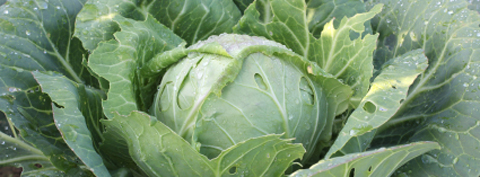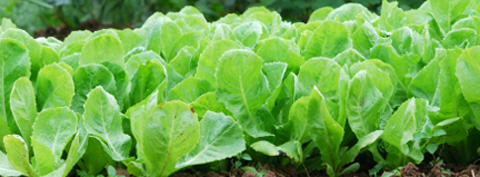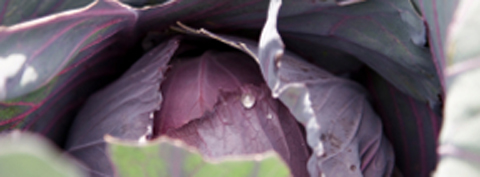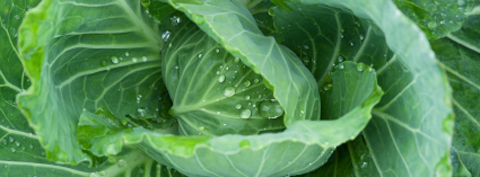Rows of cabbages with firm round heads and large arching leaves are the quintessential picture of a victory garden. Watching three or four small leaves develop into a spectacular vegetable is an experience no gardener should miss.
 Cabbage is a favorite vegetable in many cultures.
Cabbage is a favorite vegetable in many cultures.
Cabbage is easy to grow and has a sweet delicious flavor that reminds us of hearty winter meals eaten piping hot with crisp buttered bread, summer picnics with coleslaw spooned onto red plastic plates next to burgers, or baseball games and the iconic hot dogs with mustard and sauerkraut.
Every culture has its own unique culinary spin on cabbage. Germany has sauerkraut, Ireland has corned beef and cabbage, Eastern Europe has stuffed cabbage, Western Europe has cabbage soups and stews, and Asian cultures have stir fried or steamed cabbage, just to name a few.
History:
Cabbage is one of the oldest vegetables known, dating as far back as 4,000 BC. The original wild ancestor still grows in some coastal areas of Europe, but looks very different from the firm heads of cabbage we know today. Wild or sea cabbage as it’s called in France is a loose-leaf, weedy mustard plant that closely resembles kale. The cabbage we’re familiar with was developed through years of cultivation and has only been around for about 2,500 years.
Cabbage is a member of the Brassicaceae family, whose other members include broccoli, cauliflower, mustard, and turnips. This group of vegetables is also referred to as cole crops, not because of their preference for cold weather but from the Roman word caulis, meaning cabbage or stem. They’re also known as crucifers, a reference to their four-petaled flowers which form the shape of a Greek cross.
Types:
There are over 400 hundred varieties of cabbages, but essentially three main types – head cabbages, Brussels sprouts, and Chinese cabbage. Head cabbages include Savoy, green and red types. They all have firm round or flat heads with tightly wrapped leaves. Brussels sprouts, the “little cousin” to cabbage, are a recent addition to the cabbage family and have been in existence for fewer than 500 years. Chinese cabbages such as Napa and Bok Choy are closely related to cabbage and have a similar flavor, but are even more closely related to turnips.
 Brussels sprouts have only been in existence for fewer than 500 years!
Brussels sprouts have only been in existence for fewer than 500 years!
Garden centers will carry young cabbage plants in varieties that grow best in your area:
- Savoy cabbage: Named for the region in Italy where it was thought to originate, Savoy cabbage dates back to the 1500's. Sweet and tender with crinkly, yellow-green, pliable leaves that bend easily without breaking--ideal for making stuffed cabbage. It’s also delicious in soups and stews.
- Green Cabbage: The most popular of the cabbage family, green cabbage has a mild peppery taste. It forms round tight heads of smooth green leaves that can be eaten raw, boiled, or used for sauerkraut.
- Red Cabbage: Although more colorful than green cabbage, the taste is very similar. Red cabbage has a tight round head with smooth red or purple leaves, and its peppery flavor becomes more pronounced as its color deepens. Red cabbage takes longer to mature than green cabbage and therefore isn’t as tender. Commonly used as a pickling cabbage, it’s also an excellent addition to coleslaw and will brighten any salad.
- Chinese Cabbage: There are many varieties and types, but Bok Choy and Napa are among the most common. Bok Choy is sweet and succulent, with crisp white stems & dark green leaves that resemble celery. In China it’s known as Pak Choi, meaning white vegetable. Smaller varieties are valued for their tenderness and can be cooked whole, cutting down on preparation time.
- Napa is believed to have originated in the Beijing region of China, and has a slightly milder flavor. Its crisp, long, broad leaves are tightly clustered in an elongated head. Tender and delicious, it pairs well with stronger flavored ingredients and stays crisp in stir fries and soups.
- Brussels sprouts: Although much smaller than other types of cabbage, Brussels sprouts are intensely flavored and very assertive. They grow on long stems lined with miniature cabbage heads topped with a tuft of cabbage leaves. When roasted, fried, or grilled their sugars caramelize and their flavors mellow.
 Plant cabbage in early spring so you can harvest before the summer heat.
Plant cabbage in early spring so you can harvest before the summer heat.
Getting Started:
A little preparation before planting will simplify care and maximize results. Cabbages love cool weather so get started in the early spring – they can tolerate frost, but don’t grow much during the summer heat. By planting early, you can get some to harvest before the weather turns hot, rather than waiting for a bumper crop in fall.
In long-summer regions, especially where temperatures can get quite hot, it is possible to grow both a spring and a fall crop of cabbage. Consider the maturity dates when you choose a variety for your garden; this will help you select one that will produce well in your growing season and conditions.
 Red cabbage has a peppery taste that is more pronounced as the color deepens.
Red cabbage has a peppery taste that is more pronounced as the color deepens.
When choosing a location, keep in mind that cabbage needs 4 to 5 hours of direct sunlight per day, and will tolerate some shade.
Before planting, remove debris and loosen the soil, breaking up any clumps that are larger than an apple. Add compost or other organic garden mix to provide nutrients for healthy growth.
When buying plants, get a few more than you think you’ll need. Wildlife has a fondness for cabbage, and it’s best to plant a few extras in case they invade your garden!
Care Tips:
Cabbages are easy to grow, as long as you give them a good start and water regularly. If you’ve started early, you can volunteer to bring the coleslaw to every summer picnic!
Planting: Plant cabbage in rows, spacing plants about 12 to 18 inches apart and leaving 24 to 36 inches between rows for weeding and harvesting. Plants placed closer together will yield smaller, more compact cabbages.
Chinese cabbage matures more quickly and can be spaced closer at 6 to 8 inches and thinned as the plants grow larger.
 You can harvest cabbage any time after the heads form and the base is 4-10"
You can harvest cabbage any time after the heads form and the base is 4-10"
Brussels sprouts are long-season crops and mature best in cool weather. Plant in early to midsummer except in short-summer regions. In mild-winter regions they can be planted in early fall for a winter harvest. Space plants 18-24 inches apart, and rows 36 inches apart.
Watering: When it comes to watering, cabbages like consistency! Water thoroughly and deeply whenever the soil feels dry about an inch below the surface. Promote uniform soil moisture and reduce weeds by applying 2-3 inches of mulch between the rows; keeping mulch a few inches away from plant stems.
Fertilizing: Once plants are established, fertilize with a granular or time-release product to ensure a continuing supply of nitrogen to help the leaves develop. Choose a product recommended for leafy vegetables, and follow package directions. Water-soluble products may also be used, but require more frequent application for best results.
Harvesting:
Chinese cabbages can be enjoyed very soon after planting, even seedlings pulled while thinning a row can be added to a salad! Most are best when harvested within 45 to 60 days after transplanting.
Heading cabbages can be picked any time after the heads have formed and the base of the cabbage is 4 to 10 inches across - just check to be sure the heads are firm and solid. In hot summer regions, harvest before the weather gets too warm. Fall crop cabbage plants have a mild flavor, and are tolerant of cold and even a light frost. Harvest before freezing weather.
You may leave the stem and outer leaves attached to the plant for a nice little surprise-- cabbage sprouts. They will emerge from the stem and can be cut when they are 4 to 6 inches in diameter. If you will not be tending the cabbage patch for this second harvest, it is best to pull the plants to prevent pest or disease problems for future crops.
Brussels sprouts should be harvested when individual heads are bright green and about an inch in diameter—if allowed to grow too large they will become bitter. The sprouts at the bottom of the trunk-like stem mature first, and can be cut or twisted from the stem as they are ready. The sprouts sweeten after a frost, and harvest can be extended quite late into the fall or winter.
Companion Plants:
There are several flowers and herbs that help the gardener growing cabbages, deterring pests or improving growth and overall health. Plant the following in the cabbage patch as extra insurance for a bumper crop:
- Geraniums, rosemary, sage, thyme, and nasturtium protect cabbage from pests
- Dill improves the growth and health of your cabbage
- Mint and chamomile improve the flavor
 Borage improves the flavor of cabbage.
Borage improves the flavor of cabbage.
Conversely, some plants make bad neighbors, working against each other in the garden, competing for nutrients and space. Avoid planting tomatoes, peppers, strawberries and radishes near cabbage. Tomatoes can inhibit the growth of cabbage. Strawberries will affect the flavor.
Certain other plants share space well with cabbage, helping to maximize the garden space you have available. Try planting lettuce, beets, celery, onions, or potatoes with your cabbage.
Troubleshooting:
There are generally few problems with growing cabbage, but it’s helpful to be alert for those that could come up. Weather and watering are the two main factors that could hamper success. Of course, there may also be pests that are attracted to your plants – consult with your local garden center at planting time for best preventive practices, and if you do experience problems, they will be knowledgeable about how to best remedy them.
Bolting: Cabbages will “bolt” by sending up a flower stalk if plants have gone dormant and later re-awaken. Dormancy is cause by extremes - hot weather, too little water, or severe frost - and plants will begin to grow again when temperatures moderate and/or moisture returns. So resist the temptation to wait too long to harvest hoping for larger heads, and make sure to keep plants consistently watered.
Chinese cabbages Napa and Bok Choy are faster growing crops and more prone to bolting. Avoid problems by harvesting your spring crop before the hot weather takes hold, and plant a second crop in midsummer.
Split Heads: Uneven watering causes the cabbage heads to crack. If a plant suddenly receives an abundance of water, the center grows faster than the outer leaves can expand, causing the heads to split open. This may be caused by a heavy rainfall or increased irrigation. Take care not to over-water close to harvest time, and keep a close eye on your crop during periods of heavy rainfall. Harvest any split heads immediately and use right away.








